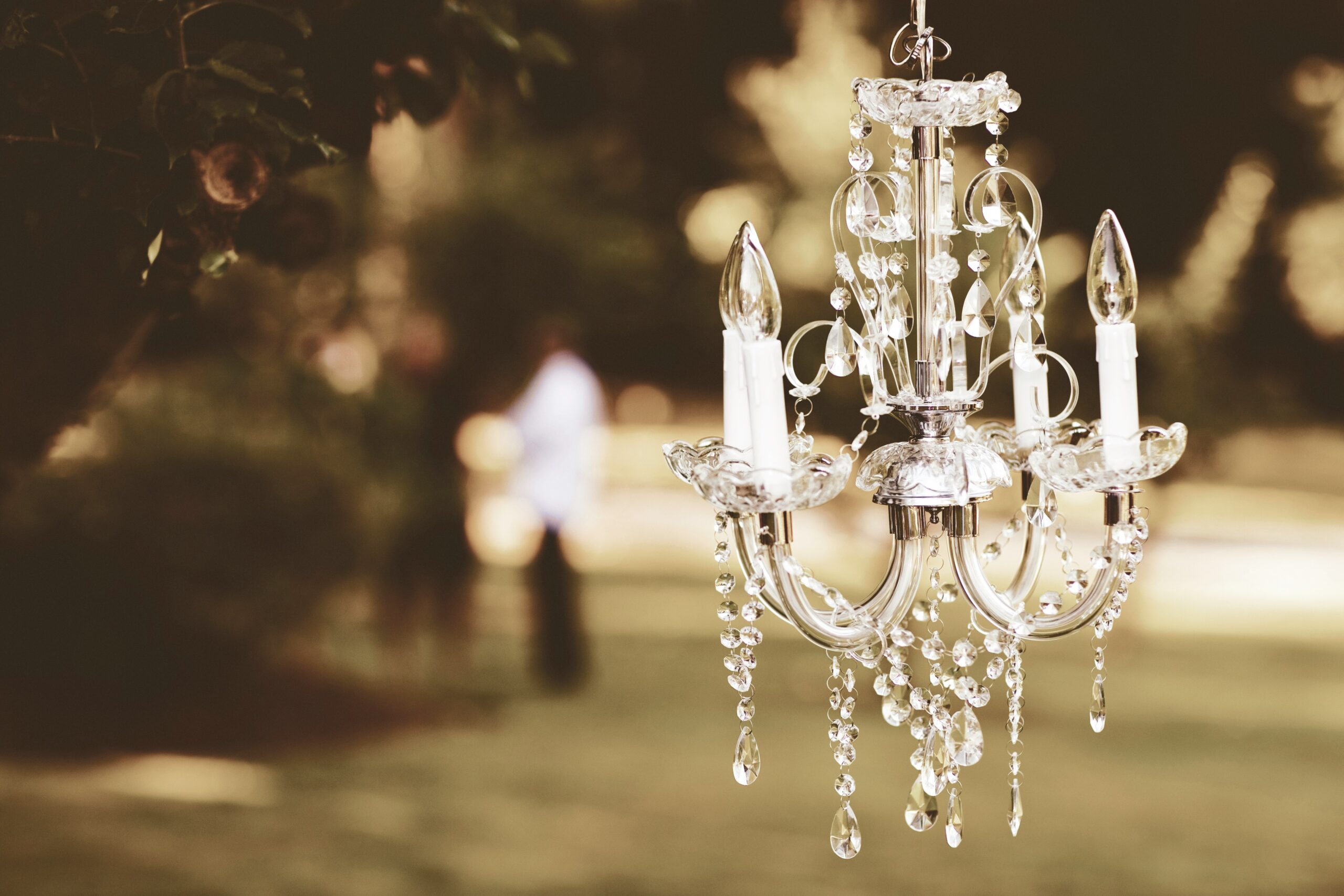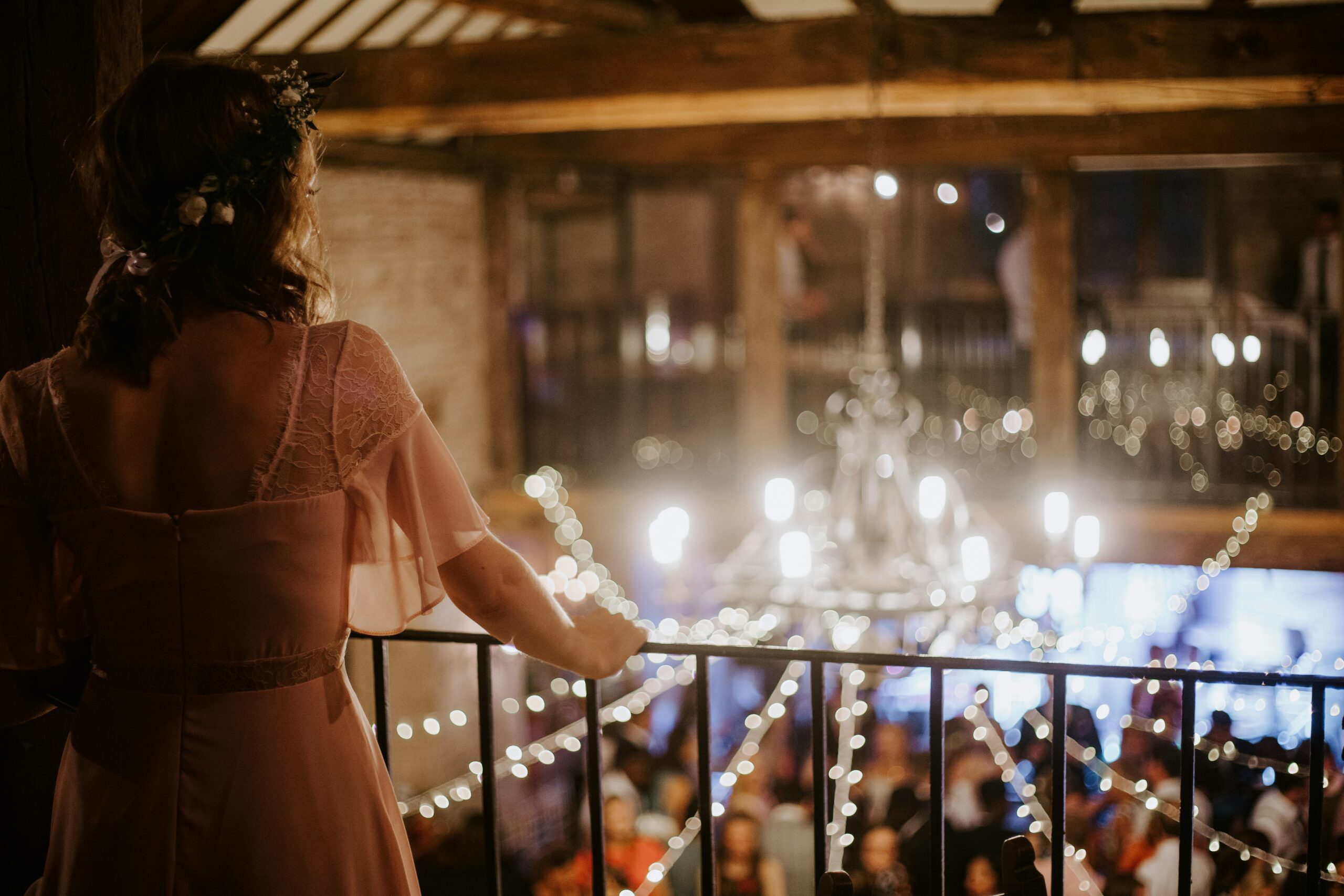Wedding lighting plays a pivotal role in setting the mood and atmosphere of your special day. This comprehensive guide explores various lighting options—from ambient to decorative—to help you select the perfect illumination for your wedding. We’ll discuss aligning lighting with your theme and venue, essential factors to consider, and creative ideas to enhance the ambiance. By the end of this guide, you’ll be well-equipped to collaborate with a wedding planner or lighting professional to create a memorable, beautifully lit celebration.
Key Takeaways
- Wedding lighting sets the mood, enhances photographs, and transforms venues to create a memorable experience.
- A well-designed lighting plan balances cost and effectiveness while avoiding common pitfalls.
- Ambient, accent, task, and decorative lighting each serve specific purposes in creating the desired atmosphere.
- Coordinating lighting with your venue, theme, and season creates a cohesive wedding environment.
- Careful budgeting and collaboration with professionals are essential for achieving the best results.
Recognize the Impact of Wedding Lighting on Your Big Day

Wedding lighting is crucial for establishing the desired ambiance and enhancing both photographs and videos. Thoughtful lighting choices can transform any venue, creating an unforgettable experience for you and your guests. Proper illumination not only avoids common pitfalls but also balances cost and effectiveness. A well-executed lighting design elevates the overall atmosphere, making colors pop and ensuring every moment is beautifully captured.
How Lighting Sets the Desired Atmosphere
Lighting can transform the mood of any venue, whether it’s a grand ballroom or an intimate marquee. Professional lighting companies can skillfully use techniques like uplighting to create a warm, romantic glow during the ceremony, transitioning to vibrant, energetic colors for the reception. By strategically placing lights, key areas such as the dance floor or the couple’s table are highlighted, guiding guests’ attention and enhancing the overall experience.
Enhancing Photos and Videos With Proper Lighting
Proper lighting significantly enhances wedding photographs and videos by capturing every detail and emotion. Photographers utilize techniques like uplighting to create depth and ambiance, while videographers rely on balanced lighting for clear, vibrant footage. Unique elements like neon lights and LED balloons add visual interest, making images and videos more memorable.
Avoiding Common Lighting Pitfalls
Avoiding common lighting pitfalls requires careful planning and professional execution. Collaborating with experienced lighting services helps prevent issues such as harsh shadows, uneven illumination, or clashing colors. Proper placement of lighting fixtures can enhance the venue’s architecture without overwhelming the space. Testing all light fixtures before the big day ensures they complement the overall design. Professional teams can balance ambient and artificial light sources to create a cohesive and flattering atmosphere for all guests.
Balancing Cost and Effectiveness in Lighting Choices
Balancing cost and effectiveness in wedding lighting is achievable by prioritizing key areas. Affordable options like fairy lights can create a magical atmosphere, while personalized elements like gobos can project custom designs onto the dance floor or ceiling. Focusing on essential lighting elements—like uplighting for the ceremony space and accent lighting for centerpieces—maximizes impact without exceeding the budget. Couples can achieve a stunning ambiance that enhances their special day by carefully selecting a mix of lighting options.
Explore Various Wedding Lighting Options

There are numerous lighting options to enhance the beauty of any wedding venue. From ambient lighting for overall warmth to accent lighting that highlights special features, you can create the perfect atmosphere for your big day. Task lighting addresses practical needs, while decorative lighting reflects personal style. Understanding the differences between indoor and outdoor lighting solutions helps choose the right fixtures for a stunning wedding design.
Ambient Lighting for Overall Warmth
Ambient lighting creates a warm, inviting atmosphere that envelops the entire wedding space. Lighting designers can use fairy lights to softly illuminate the venue, casting a gentle glow that flatters every guest. For a touch of whimsy, a disco ball can add sparkle and movement, transforming the ambiance throughout the evening. These lighting choices work together to set the mood and provide a memorable backdrop for the celebration.
Accent Lighting to Highlight Special Features
Accent lighting draws attention to key elements of your wedding and showcases special features. A well-placed chandelier can be a stunning focal point above the dance floor, while targeted spotlights highlight the wedding cake, making it a centerpiece of the reception. Lighting designers use various techniques to enhance the bride’s entrance, ensuring she shines as she walks down the aisle. Creative use of colored lights can transform ordinary spaces into magical settings, adding depth and interest to the overall design.
Task Lighting for Practical Needs
Task lighting serves practical purposes, ensuring essential areas are well-lit. Gobos can project patterns or monograms onto walls or dance floors, adding a personalized touch. For outdoor weddings, strategically placed lights illuminate pathways and seating areas. Fun options like foam light-up sticks excite the dance floor while providing extra illumination. Proper task lighting enhances safety and functionality without compromising the overall ambiance.
Decorative Lighting to Reflect Your Style
Decorative lighting allows you to express your unique vision for your wedding reception. Professional services can create custom monogram lighting to project your initials or wedding date onto the dance floor or walls, adding elegance and personalizing the venue. From romantic string lights to modern LED installations, decorative lighting options are vast, enabling you to create the perfect ambiance for your special day.
Comparing Indoor and Outdoor Lighting Solutions
Indoor and outdoor wedding lighting require different approaches. For indoor venues, uplighting can transform walls and create a warm ambiance, while outdoor settings benefit from string lights that define spaces and add a romantic glow. Fixtures like chandeliers work well indoors, but weatherproof options are necessary for outdoor events. Laser effects can create stunning displays in both environments, though they may be more impactful in larger outdoor spaces. Consider the unique challenges and opportunities of your chosen venue when selecting lighting options.
Aligning Lighting with Your Wedding Theme and Venue

Creating a cohesive atmosphere at your wedding involves carefully aligning the lighting with both your theme and venue. This includes coordinating colors and styles, assessing venue capabilities, integrating lighting with other décor elements, and considering seasonal factors. From unity candle ceremonies to the use of bistro lights, thoughtful lighting choices enhance the overall wedding experience.
Coordinating Colors and Lighting Styles
To establish a harmonious ambiance, it’s essential to match your lighting colors and styles with your wedding theme. Incorporating elements like festive string lights can add a warm glow that complements your chosen color scheme. For a romantic setting, strategically placing candles or lanterns throughout the venue enhances the atmosphere. A statement chandelier can serve as a focal point, unifying the overall lighting design. Well-coordinated lighting not only elevates the visual appeal but also benefits professional photography, ensuring every moment is beautifully captured.
Assessing Venue Capabilities and Restrictions
Before finalizing your lighting plans, it’s important to evaluate the capabilities and restrictions of your chosen venue. Some locations have built-in lighting systems or power limitations that influence your options. Additionally, venues may have specific rules regarding open flames or the installation of hanging fixtures. Discussing these factors with your venue coordinator and lighting designer ensures your vision aligns with what is both possible and permissible.
Integrating Lighting with Other Décor Elements
Combining lighting with other décor elements creates a seamless and cohesive environment. Using uplighting to highlight floral arrangements or drapery can significantly enhance their visual impact. Neon signs can double as both decoration and lighting, adding a modern touch to the venue. For the cake display, employing spotlights or pin lights draws attention to this centerpiece, making it stand out throughout the reception.
Seasonal Factors Influencing Lighting Decisions
The season of your wedding plays a significant role in determining appropriate lighting choices. In summer, softer lighting often complements the natural daylight, while winter weddings may benefit from more dramatic illumination to create warmth and ambiance. Fall events can incorporate amber hues to reflect the season’s colors, and spring weddings might use pastel-tinted lights to enhance themes of freshness and renewal. Lighting designers consider these seasonal elements to craft the perfect atmosphere for each unique celebration.
Essential Factors to Consider When Selecting Lighting

Choosing the right wedding lighting involves careful consideration of several key factors. Planning your lighting budget, understanding power needs and logistics, collaborating effectively with vendors and coordinators, and ensuring safety for all attendees are crucial steps. These elements contribute to a beautiful and well-executed lighting design that enhances the overall wedding experience.
Planning Your Lighting Budget
Establishing a lighting budget requires thoughtful planning. Depending on the venue and desired effects, it’s advisable to allocate approximately 10–15% of your total wedding budget to lighting. Cost savings can be achieved by prioritizing key areas like the dance floor and ceremony space while opting for more affordable options in less prominent locations. Renting equipment is often more economical than purchasing, and working with a professional lighting designer can help maximize the impact of your budget.
Understanding Power Needs and Logistics
A clear understanding of power requirements and logistical considerations is essential for successful wedding lighting. Collaborate with your venue and lighting professionals to determine available power sources and any additional needs. For outdoor weddings, generators might be necessary to support lighting equipment.
Collaborating with Vendors and Coordinators
Effective collaboration with vendors and coordinators is vital for seamless execution. Communicate your vision clearly to your lighting designer, DJ, and venue coordinator to ensure all elements harmonize harmoniously. Regular meetings and updates help keep everyone aligned on the lighting plan, timeline, and any changes. Professional coordinators can manage the setup and takedown, allowing you to focus on enjoying your special day.
Key Roles in Wedding Lighting Coordination
Ensuring Safety for Guests and Staff
Safety is a critical aspect of wedding lighting design. Proper cable management prevents tripping hazards, and secure mounting of fixtures eliminates risks. Choosing fire-resistant materials for decorative elements and ensuring all electrical equipment meets safety standards are essential steps. A professional lighting team can implement these measures effectively, creating a beautiful and secure environment for your celebration:
- Secure cables to prevent tripping.
- Properly mount fixtures to avoid hazards.
- Use fire-resistant materials for decorations.
- Ensure electrical equipment complies with safety standards.
- Hire professionals for proper implementation.
Key Questions to Ask Potential Vendors
When choosing a lighting professional, ask important questions to ensure a good fit. Inquire about their experience with similar venues and wedding styles. Ask about the types of lighting equipment available and whether they can accommodate specific requests. Discuss setup and breakdown processes, as well as backup plans in case of equipment failure.
Essential Questions for Lighting Vendors
Evaluating Portfolios and Client Testimonials
Reviewing portfolios and client testimonials offers insights into a professional’s capabilities and reliability. Examine their past work to ensure their style aligns with your desired aesthetic. Reading reviews from previous clients can reveal important information about their professionalism, punctuality, and ability to handle unexpected challenges. This research helps you make an informed decision.
Understanding Service Agreements and Packages
When choosing a lighting professional, carefully review service agreements and packages. Understand what equipment and services are included, setup and breakdown times, and any additional fees. Clarify the payment schedule and cancellation policy. Some vendors offer customizable packages, allowing you to tailor the lighting design to your specific needs and budget.
Collaborating with Other Professionals for Cohesion
Collaborating with other wedding professionals ensures a cohesive lighting design that complements all aspects of the event. Lighting experts should work closely with your wedding planner, florist, and venue manager to create a unified vision. This teamwork allows for the seamless integration of lighting with decor, music, and the overall timeline, resulting in a harmonious and memorable atmosphere.
Enhancing Ambiance with Creative Lighting Ideas

Creative lighting ideas can significantly enhance your wedding ambiance. Candles and lanterns create intimacy, while string lights add whimsy. Highlighting key areas like the dance floor and cake table draws attention, and Gobo lighting effects offer personalization. Embracing new trends in LED and smart lighting provides innovative options. These techniques help you craft a unique atmosphere for your special day.
Using Candles and Lanterns for an Intimate Setting
Candles and lanterns cast a warm glow that enhances the romantic atmosphere of a wedding. Placing pillar candles along the aisle or clustering tea lights on reception tables creates a soft, flickering light. Hanging lanterns from trees or tent poles adds a magical touch to outdoor celebrations. When using open flames, check venue policies and consider battery-operated alternatives for safety.
Adding String Lights for a Whimsical Touch
String lights add a whimsical touch and create a magical atmosphere. Drape them across ceilings, wrap them around pillars, or hang them in curtain-like formations to define spaces. For outdoor weddings, string lights between trees or along fences provide an enchanting glow as evening falls. This versatile option works well with various themes, from rustic barn celebrations to elegant garden parties.
Highlighting Key Areas Like the Dance Floor and Cake Table
Strategically lighting key areas like the dance floor and cake table draws attention and creates focal points. Use spotlights or pin lights to illuminate the cake, making it a centerpiece throughout the reception. For the dance floor, color-changing LED lights or a disco ball can create an energetic atmosphere. By focusing light on these important areas, you ensure special moments are beautifully lit for photos and memories.
Personalizing with Gobo Lighting Effects
Gobo lighting effects offer a unique way to personalize your venue. Project your monogram, wedding date, or custom designs onto walls, dance floors, or ceilings. These projected images create striking visuals that connect your theme and add a personal touch. Lighting designers can transform plain spaces into elegant, customized environments that reflect your style.
Embracing New Trends Like LED and Smart Lighting
LED and smart lighting technologies provide innovative options for modern weddings. Color-changing LED fixtures allow you to adjust the ambiance throughout the evening, transitioning from soft hues during dinner to vibrant colors for dancing. Smart lighting systems enable precise control over brightness and color, often managed through smartphone apps. These advanced solutions offer flexibility and creativity, allowing you to customize your venue’s atmosphere in real time.
Conclusion
Choosing the right wedding lighting is essential for creating a memorable and enchanting atmosphere on your special day. From setting the mood and enhancing photographs to reflecting your personal style and theme, thoughtful lighting design can transform any venue into a magical space. By considering factors such as budget, venue capabilities, and safety, you can work with lighting professionals to craft a unique ambiance that perfectly complements your vision. Investing time and effort in selecting appropriate lighting options ensures every moment of your wedding is beautifully illuminated, leaving lasting impressions on you and your guests.
FAQs
Why is wedding lighting important?
Wedding lighting is crucial for setting the mood and enhancing the atmosphere of your event. It highlights key areas like the dance floor and cake table, creates a memorable experience for guests, and improves the quality of your photographs and videos.
What are some popular types of wedding lighting?
Popular lighting includes ambient lighting for overall warmth, accent lighting to highlight special features, task lighting for practical needs, and decorative lighting to personalize the venue. Options like string lights, uplighting, and chandeliers are frequently used for both indoor and outdoor settings.
How do I coordinate lighting with my wedding theme and venue?
Choose lighting styles and colors that complement your decor to align lighting with your theme. Assess venue restrictions, such as power limitations or rules about open flames, and integrate lighting with other elements like flowers or drapery to create a cohesive atmosphere.
How can I incorporate affordable lighting options into my wedding?
Affordable lighting options include fairy lights, candles, and DIY lanterns. Focusing on key areas like the ceremony space and reception centerpieces can help you maximize the impact of your lighting without exceeding your budget.
What should I consider when hiring a lighting professional?
When hiring a lighting professional, ask about their experience with your venue, the types of lighting they offer, and their backup plans. Review their portfolio and testimonials to ensure they align with your vision, and carefully review service agreements and packages to understand what’s included.

